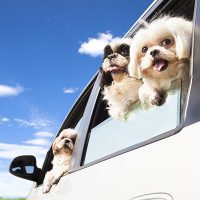According to the American Automobile Association, over 80% of dog owners drive with their pet in the car. That’s a lot of pets traveling in motor vehicles—it’s important for you to make sure your animal companion stays safe! Here are a few key vehicle safety tips for your pet:
In the Garage
There are several safety hazards to consider before you’ve even left home. Always check that your pet isn’t in the garage when you’re pulling out. Cats, in particular, like to hide under cars and can be seriously injured or worse if they become trapped under your vehicle. Never leave your car running while your pet is in the garage, as the noxious carbon monoxide fumes can do serious damage.
Heatstroke Risk
Did you know that the temperature inside a parked car on a hot day can skyrocket to well over 100 degrees Fahrenheit in a half-hour? Never leave your pet inside a parked car, even on cloudy days, because the risk of heatstroke is simply too great. Cracking a window won’t do the trick, either—it’s best to simply leave your pet at home.
Short Trips
For shorter trips in the car, perhaps to the vet’s office or to a dog park, it’s important to make sure your pet is properly restrained. A pet who roams free in the car can be seriously injured in the event of an accident, or they can cause an accident themselves by interfering with the driver. Keep your pet in a carrier, or use a specialized car harness, to secure your animal friend.
Never allow your dog to put their head out of the window while you’re driving. Debris from the road could strike your dog’s face or body, potentially causing serious injury. You also run the risk of your dog falling out of the vehicle should you have to make a sharp turn or stop.
Long Trips
Thinking of taking your pet on a longer road trip? Apply the same rules above when it comes to safely restraining them. Take frequent breaks throughout your trip to allow your pet to use the bathroom and get a drink. Consider packing some safe and healthy snacks for your dog, such as certain fruits, to keep them satisfied during the journey. Last but not least, check with your destination before leaving home to make sure that it’s pet-friendly.
Our Advice on Vehicle Safety Tips for Your Pet in 2024
Why is it important to check for pets in the garage before leaving?
Checking for pets in the garage before leaving is crucial to prevent accidents and ensure their safety. Pets, especially cats, are known to find hiding spots under or around vehicles, where they can be seriously injured or worse if a car moves unexpectedly. Additionally, the garage can contain hazardous substances that pose a risk if pets are left unsupervised. Ensuring your garage is pet-free before departing eliminates the risk of tragic accidents and ensures that toxic substances are out of reach, safeguarding your pet’s well-being.
What are the dangers of leaving pets in a parked car?
Leaving pets in a parked car poses severe risks, including heatstroke and suffocation, as temperatures can soar to life-threatening levels within minutes, even on cloudy days or with windows slightly open. Pets can quickly become dehydrated and experience distress or fatal heatstroke. Additionally, there’s a risk of pets being stolen if left unattended. These scenarios highlight the importance of never leaving pets in parked vehicles, as the internal car environment can rapidly become a dangerous, potentially lethal situation for any animal.
How should pets be restrained during short car trips?
During short car trips, pets should be appropriately restrained to ensure their safety and prevent distractions to the driver. This can be achieved using a pet carrier or a crash-tested pet seatbelt harness designed for their size and weight. The carrier should be secured in place to prevent movement during transit. A harness that attaches to the car’s seatbelt system is ideal for dogs, providing them with some mobility while keeping them safe. These precautions minimize the risk of injury in sudden stops or accidents, making the journey safer for everyone involved.
What risks are associated with allowing a dog to put its head out of the car window?
Allowing a dog to put its head out of the car window exposes it to several risks, including injury from debris or objects flying at high speeds, which can cause harm to the eyes, nose, or mouth. There’s also the risk of ear injuries from the force of the wind and potential respiratory issues from inhaling particles. Moreover, sudden stops or turns could lead to the dog being thrown from the car, resulting in severe injury or worse. These hazards underscore why keeping dogs inside the vehicle is safer and securely restrained.
What precautions should be taken for pets on longer road trips?
Several precautions are essential for longer road trips with pets for their safety and comfort. First, use a crash-tested carrier or harness to ensure your pet is comfortably restrained. Schedule regular stops every 2-3 hours for bathroom breaks, exercise, and hydration. Keep the vehicle’s interior temperature controlled, and never leave pets alone in a parked car to avoid heatstroke. Bring familiar items like toys or blankets to reduce stress, and ensure they have access to water and are fed according to their usual routine. Finally, please verify that your pet’s current vaccinations carry their medical records, especially for interstate travel.
A final tip: make sure your pet is healthy enough for travel. Set up an appointment at your vet’s office in Hobe Sound, FL today to have your pet examined. Our Veterinary Wellness & Pet Vaccinations services can help ensure your pet is ready for any upcoming trips.




